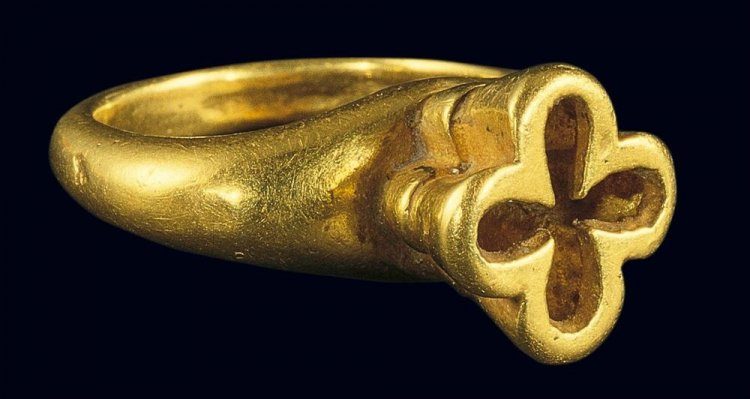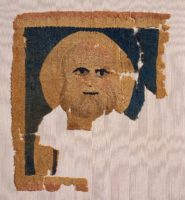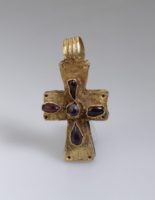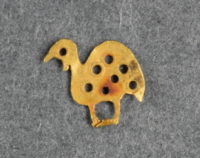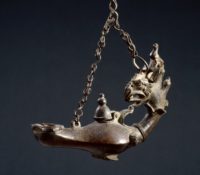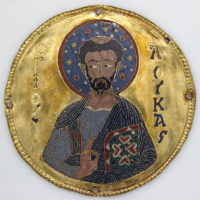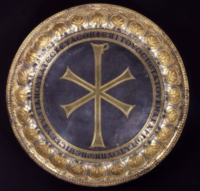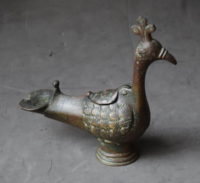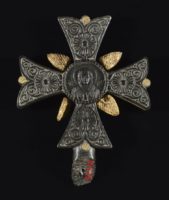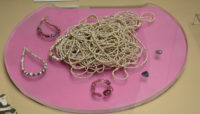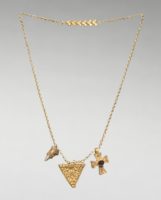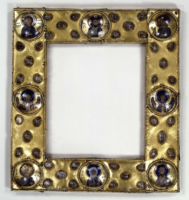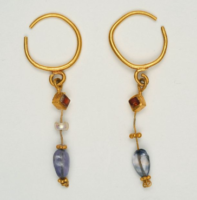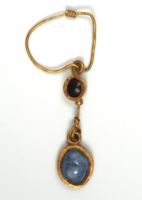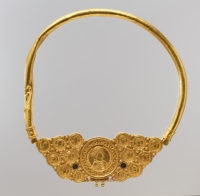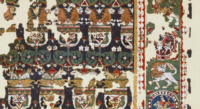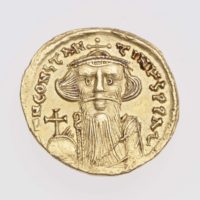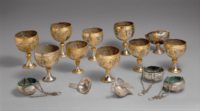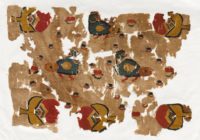Ring with cross-shaped quatrefoil calyx bezel. Materials: gold. Period: Early Byzantine; circa: 6th-7th century. The Benaki Museum of Greek Culture is housed in one of the most beautiful neoclassical-style buildings in Athens, near the National Garden and the Hellenic Parliament.
Tapestry panel: Head of a man. Coptic, Egypt. Period: Early Byzantine circa: 4th-5th century A.D. Dimensions: 23.5 x 20 cm (9 1/4 x 7 7/8 in.); Legacy dimension: 23.5 x 20.0 cm. Materials: Wool. The MFA is open 7 days a week. Monday and Tuesday 10 am–5 pm, Wednesday–Friday 10 am–10 pm, Saturday and Sunday 10 am–5 pm.
Bracelet with Panthers, Period: Early Byzantine, Found in Hadra near Alexandria (Egypt). Material: gold. The museum is open to the public Tuesday through Sunday, 11:30 a.m.–5:30 p.m., except for federal holidays.
Cross, Period: Early Byzantine, circa: 5th-6th century, Materials: golad and garnet. Dimensions: 3,8×1,9 cm. The collection of the State Hermitage includes over 3 million works of art and world culture artefacts. It contains paintings, graphic works, sculptures, works of applied art, archaeological artefacts and numismatic objects. The Hermitage is considered to have been founded in 1764, when Empress Catherine the Great acquired an impressive collection of works from the Berlin merchant Johann Ernst Gotzkowsky. The museum celebrates the anniversary of its founding each year on 7 December, St. Catherine’s Day. Opening Hours: Tuesday, Thursday, Saturday, Sunday: 10.30-18.00 Wednesday, Friday: 10.30-21.00 Closed: Monday.
Personal Ornament; Period: Early Byzantine; circa: 6thc.-7thc. Material: Gold. Length: 8 millimetres , Width: 7 millimetres. British Museum is closed 24, 25 and 26 December and 1 January, but is open every other day of the year. Fast facts about the British Museum: Founded: 1753, Collection size: 8 million objects, Oldest object in the collection: Stone chopping tool (nearly 2 million years old).
Gold coin of Constantine IV; Period: Early Byzantine Period; Date: 654-685; Minted in Rome. British Museum is closed 24, 25 and 26 December and 1 January, but is open every other day of the year. Fast facts about the British Museum: Founded: 1753, Collection size: 8 million objects, Oldest object in the collection: Stone chopping tool (nearly 2 million years old).
Lamp for suspension; Period: Early Byzantine. circa: 4thc-5thc. Materials: Brass; the curved handle in the shape of the head and neck of a crested dragon holding an apple in its mouth, and bearing on its head a sacred monogram surmounted by a dove. Subjects:leaf, fruit, dragon and bird. Found Place: Herculaneum, Naples.
Dimensions: Length: 21 centimetresHeight: 15.7 centimetres (lamp)Width: 7.2 centimetresHeight: 41.2 centimetres (including chain)Weight: 1.126 kilograms. British Museum is closed 24, 25 and 26 December and 1 January, but is open every other day of the year. Fast facts about the British Museum: Founded: 1753, Collection size: 8 million objects, Oldest object in the collection: Stone chopping tool (nearly 2 million years old).
Medallion with Saint Luke from an Icon Frame, Period: Middle Byzantine, circa: ca. 1100, Made in Constantinople, Materials: Gold, silver, and enamel worked in cloisonné, Dimensions: Diam: 3 1/4 in. (8.3 cm) Mount: 20 1/2 x 15 x 7/8 in. (52.1 x 38.1 x 2.2 cm), On view at The Met Fifth Avenue in Gallery 303. The Metropolitan Museum of Art (New York) is one of the world’s largest and finest art museums. Its collection includes more than two million works of art spanning five thousand years of world culture, from prehistory to the present and from every part of the globe. Public Hours: 10:30 a.m.–5:30 p.m. Open seven days a week.
Paten with Christogram and Repousse Border, Period: Early Byzantine, circa Mid 6th Century. Materials: silver, gilding and niello. The museum is open to the public Tuesday through Sunday, 11:30 a.m.–5:30 p.m., except for federal holidays.
Lamp for a Stand, Period: Early Byzantine. Material: Bronze. Found: Egypt. In the shape of a peacock, with circular foot; the spout is at the end of the tail, and the hole for filling in the back is covered by a hinged leaf-shaped lid.
British Museum is closed 24, 25 and 26 December and 1 January, but is open every other day of the year. Fast facts about the British Museum: Founded: 1753, Collection size: 8 million objects, Oldest object in the collection: Stone chopping tool (nearly 2 million years old).
Benediction Cross, Period: Late Byzantine, circa: 1200s-1400s. Materials: black schist, gold, silver. The Cleveland Art Museum Hours: Tuesdays, Thursdays, Saturdays, Sundays 10:00 a.m.–5:00 p.m. Wednesdays, Fridays 10:00 a.m.–9:00 p.m. Closed Mondays.
Quantity of pearl, tourmaline, glass, coral and bronze beads, once attached no doubt to cloth. Period: Early Byzantine circa: 6-7th century. Made in/Findspot: Constantinople. In the Istanbul Archaeological Museum collections, there are rich and very important works of art belonging to various civilizations from the regions from Africa to Balkans , from Anatolia and Mesopotamia to Arab Peninsula and Afghanistan that were in the borders of the Ottoman Empire.
Chain with Two Pendants and a Cross, Period: Early Byzantine; circa: 6th century. Type of art work: Jewelry Materials: gold with granulation and a garnet. Overall: h. 45.7 cm (18 in.); Part 1: 2.6 x 2.6 cm (1 x 1 in.); Part 2: 2.8 x 1.9 cm (1 1/16 x 3/4 in.); Part 3: 1.9 x 1.1 cm (3/4 x 7/16 in.). The Cleveland Art Museum Hours: Tuesdays, Thursdays, Saturdays, Sundays 10:00 a.m.–5:00 p.m. Wednesdays, Fridays 10:00 a.m.–9:00 p.m. Closed Mondays.
Icon Frame, Period: Middle Byzantine, circa: Mid-11th century. Size: 22 x 20 (8.7 x 7.9). Materials: enamel on gilt silver. The museum is open to the public Tuesday through Sunday, 11:30 a.m.–5:30 p.m., except for federal holidays.
Pair of Earrings. Materials: Pearls, Sapphires, Gold, Gems and Gold Globules. Period: Early Byzantine, circa: Early 5th Century. The museum is open to the public Tuesday through Sunday, 11:30 a.m.–5:30 p.m., except for federal holidays.
Earring, Materials: Ruby, Sapphire, Gold and Gems. Period: Early Byzantine, early 5th century. Found in 1910 during restoration work in Piazza della Consolazione, Rome. The museum is open to the public Tuesday through Sunday, 11:30 a.m.–5:30 p.m., except for federal holidays.
Pectoral with Coins and Pseudo-Medallion, Period: Early Byzantine, circa: 539–50, Materials: Gold, niello, On view at The Met Fifth Avenue in Gallery 302. The Metropolitan Museum of Art (New York) is one of the world’s largest and finest art museums. Its collection includes more than two million works of art spanning five thousand years of world culture, from prehistory to the present and from every part of the globe. Public Hours: 10:30 a.m.–5:30 p.m. Open seven days a week.
Horse and Lion Hanging, Period: Early Byzantine, 6th century A.D. Materials: wool and linen. The museum is open to the public Tuesday through Sunday, 11:30 a.m.–5:30 p.m., except for federal holidays.
Solidus of Constantinus III, Mint: Constantinople, Period: A.D. 641–668, Early Byzantine. Material: Gold. The MFA is open 7 days a week. Monday and Tuesday 10 am–5 pm, Wednesday–Friday 10 am–10 pm, Saturday and Sunday 10 am–5 pm.
The Attarouthi Treasure, Period: Early Byzantine, circa: 500-650s. Made in Attarouthi, Syria. Materials: Silver, silver-gilt. On view at The Met Fifth Avenue in Gallery 300.
These well-wrought liturgical items– chalices, censers, a filter, and also a depiction of the dove of the Holy Spirit– were amongst the belongings of a Christian church in the wealthy seller city of Attarouthi in Syria, after that among the wealthiest lands of the Byzantine Empire. The chalices, censers, and also filter were made use of for the Divine Liturgy, or Eucharist, where Christians take consecrated wine and bread in ceremony of the Last Supper and also Christ’s death. According to their inscriptions, written in Greek with several spelling variants, many of the objects were offerings of local citizens to the major church of the town, which was dedicated to Saint Stephen, and to a smaller church dedicated to Saint John (probably Saint John the Forerunner [the Baptist]). In the very early 7th century Syria dropped initially to the Sasanian Persians and afterwards to the militaries of Islam. These works were most likely hidden in haste in a safety container at some minute when the Byzantine military was pulling away from strikes on the area.
The Metropolitan Museum of Art (New York) is one of the world’s largest and finest art museums. Its collection includes more than two million works of art spanning five thousand years of world culture, from prehistory to the present and from every part of the globe. Public Hours: 10:30 a.m.–5:30 p.m. Open seven days a week.
[xyz-ihs snippet="Met-Museum-Booking"]Fragment of a Curtain, Period: Early Byzantine circa: 500s. Made in: Egypt, Materials: tabby weave, inwoven tapestry ornament; wool and linen, Overall: 38 x 52.3 cm (14 15/16 x 20 9/16 in.). The Cleveland Art Museum Hours: Tuesdays, Thursdays, Saturdays, Sundays 10:00 a.m.–5:00 p.m. Wednesdays, Fridays 10:00 a.m.–9:00 p.m. Closed Mondays.


